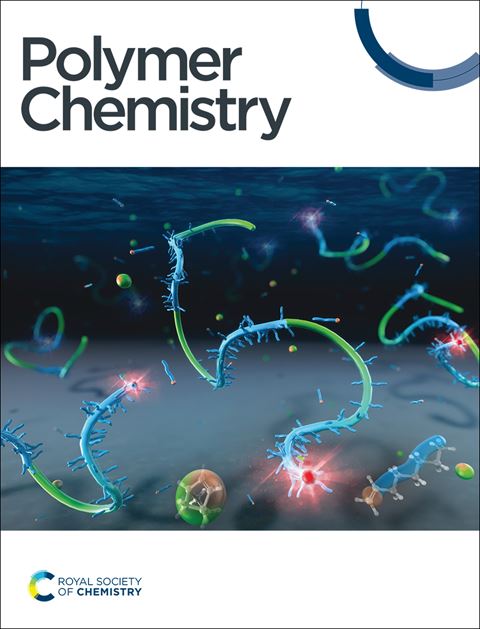用于合成从塑性聚乙烯到弹性聚乙烯的苯并叔丁基 "三明治 "型非对称α-二亚胺镍前催化剂
IF 3.9
2区 化学
Q2 POLYMER SCIENCE
引用次数: 0
摘要
通过精确控制α-二亚胺镍/钯配合物的走链和链转移能力,可以生成具有前所未有的热学、流变学和机械性能的支链聚乙烯。在本研究中,通过将 2,4,6-三(5-二苯并环丁烯基)苯胺掺入经典的 α-二亚胺配体,设计并制备了一系列新的 "三明治 "型非对称镍前催化剂,用于乙烯聚合。这些镍前催化剂具有三明治立体结构,并以乙基倍半铝活化,表现出罕见的催化活性(高达 32.46 × 106 gPE/molNi h),并能调节聚乙烯的分子量、支化度和熔融温度。在工业化条件下,其催化活性高达 4.31 × 106 gPE/molNi h,这证明了其特有的热稳定性。随着配体取代基和聚合温度的变化,聚乙烯的微观结构从中等支化(77/1000C)到低支化(33/1000C)不等。支化数量的减少导致熔融温度升高,接近半结晶聚乙烯的特性。这相当于将弹性聚乙烯转化为具有出色拉伸强度的塑性聚乙烯。值得注意的是,与之前报道的 "三明治"(8-对甲苯基萘基 α-二亚胺)镍(II)催化剂相比,该催化剂的分支数量明显较少,这可能是由于轴向封端芳基与苊单元之间的非共价相互作用所致。此外,含有 N-烷基单元的催化剂完全没有活性,而含有 N-芳基单元的类似物在乙烯聚合中却具有很高的活性,这为乙烯聚合催化剂的设计理念提供了启示。本文章由计算机程序翻译,如有差异,请以英文原文为准。

Benzosuberyl installed “sandwich” type unsymmetrical α-diimine nickel precatalysts for synthesizing plastomeric to elastomeric polyethylene†
Precise control over the chain walking and chain transfer capabilities of α-diimine nickel/palladium complexes can generate branched polyethylene with unprecedented thermal, rheological, and mechanical properties. In the present study, with the incorporation of 2,4,6-tris(5-dibenzosuberyl)aniline into the classical α-diimine ligand, a new family of “sandwich” type unsymmetrical nickel precatalysts was designed and prepared for ethylene polymerization. The nickel precatalysts, featuring sandwich steric structures and activated with ethylaluminium sesquichloride, exhibited rarely achieved catalytic activities (up to 32.46 × 106 gPE molNi−1 h−1) and were able to tune the molecular weight, branching degree and melt temperature of the resulting polyethylene. A high catalytic activity of 4.31 × 106 gPE molNi−1 h−1 under industrially relevant conditions demonstrated their characteristic thermal stability. With changes in ligand substituents and polymerization temperature, the microstructure varied from moderately branched (77/1000C) to less branched (33/1000C) polyethylene. The reduced number of branches resulted in higher melt temperatures, approaching the characteristics of semi-crystalline polyethylene. This corresponded to the conversion of elastomeric to plastomeric polyethylene with excellent tensile strength. Notably, the number of branches is significantly lower than those of previously reported “sandwich” (8-p-tolyl naphthyl α-diimine)nickel(ii) catalysts, perhaps due to non-covalent interactions between the axial capping aryl group and the acenaphthene unit. Moreover, N-alkyl unit containing catalysts were completely inactive, while their N-aryl unit bearing analogues were highly active in ethylene polymerization, shedding light on the concept of catalyst design for ethylene polymerization.
求助全文
通过发布文献求助,成功后即可免费获取论文全文。
去求助
来源期刊

Polymer Chemistry
POLYMER SCIENCE-
CiteScore
8.60
自引率
8.70%
发文量
535
审稿时长
1.7 months
期刊介绍:
Polymer Chemistry welcomes submissions in all areas of polymer science that have a strong focus on macromolecular chemistry. Manuscripts may cover a broad range of fields, yet no direct application focus is required.
 求助内容:
求助内容: 应助结果提醒方式:
应助结果提醒方式:


